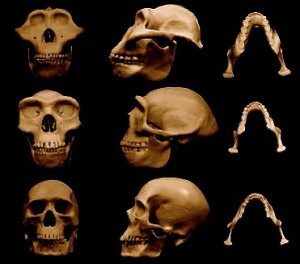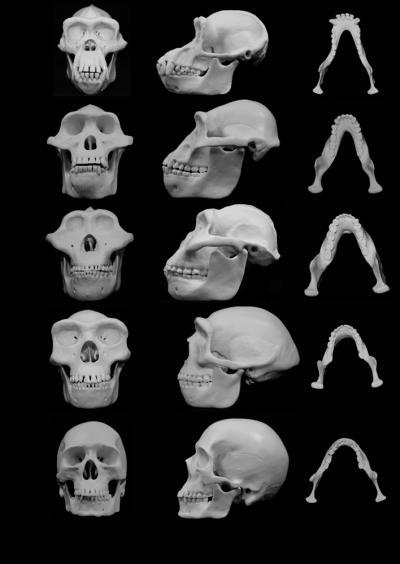
scientists have reported a study that suggests that all human males can trace their roots to an ancestor with violent tendencies — a hominin who was not a gentle, ‘noble savage’ whose descendents were later corrupted or changed by the onset of society, as depicted or suggested by many theorists.
University of Utah biologist David Carrier and Michael H. Morgan, a University of Utah physician, have been conducting a comprehensive study of the human fossil record, including that of Australopithecus, an extinct hominin species that is thought to be ancestral to Homo (the human genus of which Homo sapiens, or the modern human, is the soul surviving species). What they have consistently found, among other things, is that certain bones of the face of the male skull have become increasingly more robust over several million years of evolution, and that these bones were critical for protection against impact from objects — like a human fist, which, they maintain, has also evolved over time to form a more effective fist for striking.
“The australopiths were characterized by a suite of traits that may have improved fighting ability, including hand proportions that allow formation of a fist; effectively turning the delicate musculoskeletal system of the hand into a club effective for striking,” said Carrier. “If indeed the evolution of our hand proportions were associated with selection for fighting behavior you might expect the primary target, the face, to have undergone evolution to better protect it from injury when punched.”
Their study of the bones of the face and cranium supported that hunch.
“When modern humans fight hand-to-hand the face is usually the primary target,” said Carrier. “What we found was that the bones that suffer the highest rates of fracture in fights are the same parts of the skull that exhibited the greatest increase in robusticity during the evolution of basal hominins. These bones are also the parts of the skull that show the greatest difference between males and females in both australopiths and humans. In other words, male and female faces are different because the parts of the skull that break in fights are bigger in males. Importantly, these facial features appear in the fossil record at approximately the same time that our ancestors evolved hand proportions that allow the formation of a fist. Together these observations suggest that many of the facial features that characterize early hominins may have evolved to protect the face from injury during fighting with fists.”
______________________________________
 University of Utah biologist David Carrier and Michael H. Morgan, a University of Utah physician, contend that human faces — especially those of our australopith ancestors — evolved to minimize injury from punches to the face during fights between males. Their research is published in the June 9 issue of Biological Reviews. Image courtesy University of Utah
University of Utah biologist David Carrier and Michael H. Morgan, a University of Utah physician, contend that human faces — especially those of our australopith ancestors — evolved to minimize injury from punches to the face during fights between males. Their research is published in the June 9 issue of Biological Reviews. Image courtesy University of Utah
___________________________________________________
The findings may have important implications for understanding human nature, and will no doubt become part of the general debate about human evolution.
“The debate over whether or not there is a dark side to human nature goes back to the French philosopher Rousseau who argued that before civilization humans were noble savages; that civilization actually corrupted humans and made us more violent,” said Carrier. “This idea remains strong in the social sciences and in recent decades has been supported by a handful of outspoken evolutionary biologists and anthropologists. Many other evolutionary biologists, however, find evidence that our distant past was not peaceful.”
“The hypothesis that our early ancestors were aggressive could be falsified if we found that the anatomical characters that distinguish us from other primates did not improve fighting ability. What our research has been showing is that many of the anatomical characters of great apes and our ancestors, the early hominins (such as bipedal posture, the proportions of our hands and the shape of our faces) do, in fact, improve fighting performance.”
The theory that humans evolved from a violent ancestor is actually a long-standing and contentious one. It was Raymond Dart, South African anatomist and discoverer of the famous fossilized ‘Taung child’ Australopithecus skull in 1924, who advanced the theory that humans evolved from a “killer ape”, supporting the hypothesis that war and interpersonal aggression was the driving force behind human evolution. The writer Robert Ardrey, author of African Genesis and The Territorial Imperative, further popularized the theory through his books during the 1960’s. But the notion has encountered stiff resistance or dispute among other scholars and anthropologists over the years, whose research has indicated that this is not necessarily the case.
Carrier and Morgan make it clear, however, that their study results are not about casting humans as a hopelessly violent and destructive species.
“Our research is about peace,” said Morgan. “We seek to explore, understand, and confront humankind’s violent and aggressive tendencies. Peace begins with ourselves and is ultimately achieved through disciplined self-analysis and an understanding of where we’ve come from as a species. Through our research we hope to look [at] ourselves in the mirror and begin the difficult work of changing ourselves for the better.”
Their paper, titled “Protective buttressing of the hominin face,” is published in the journal Biological Reviews.
_____________________________________________
Source: Statements by David Carrier and Michael Morgan re-published from a University of Utah press release.
Cover Photo, Top Left: Courtesy University of Utah
_____________________________________________
Read about the most fascinating discoveries with a premium subscription to Popular Archaeology Magazine. Find out what Popular Archaeology Magazine is all about. AND MORE:
On the go? Purchase the mobile version of the current issue of Popular Archaeology Magazine here for only $2.99.
Popular Archaeology’s annual Discovery Edition eBook is a selection of the best stories published in Popular Archaeology Magazine in past issues, with an emphasis on some of the most significant, groundbreaking, or fascinating discoveries in the fields of archaeology and paleoanthropology and related fields. At least some of the articles have been updated or revised specifically for the Discovery edition. We can confidently say that there is no other single issue of an archaeology-related magazine, paper print or online, that contains as much major feature article content as this one. The latest issue, volume 2, has just been released. Go to the Discovery edition page for more information.



